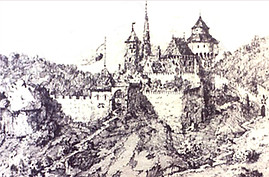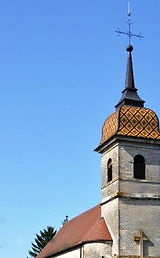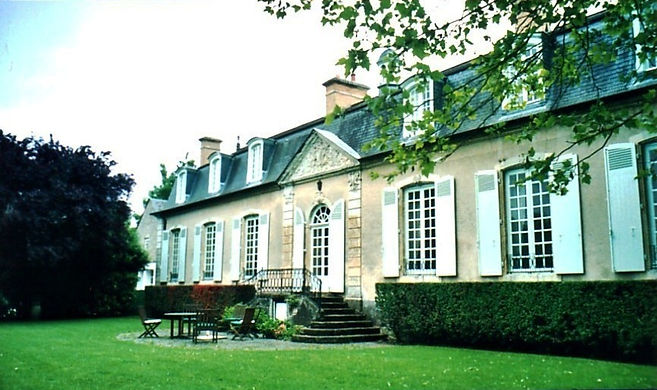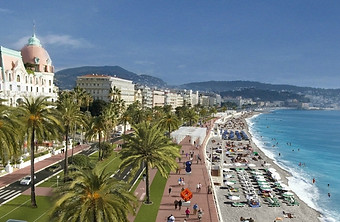Grimont Castle
(est. 850 - 1643)
Poligny - Jura - France
The fortified Grimont castel would have been founded in the 9th century by the ancestor of the House of Poligny, the count Girart de Roussillon (819 - 877).
The powerful fortified castle of Poligny and its keep are among the first to be built at this time in height, on the side of a cliff. Established on Mount Grimont, it occupies an area of approximately 3 hectares, surrounded by a fortified rampart of 800 m.
This fortified castle with its powerful natural geological defense, is considered to be one of the safest in the region.
The Dukes of Burgundy sheltered their charters , seals , banners , treasures , entrusted to the treasurer of the charters (the treasure was transferred to the castle of Dole in 1561, following a fire).
Among the long line of Poligny, several ensured the captaincy of Grimont castel;
- Eudes from 1261
- his son Odon ( the latter having raised in his house the children of Count Hugues of Burgundy and Countess Alix )
- Jean II in 1412.
During the Franco-Spanish War (1635-1659), King Louis XIII and his Prime Minister Cardinal Richelieu instructed their vassal, Duke Henri II of Orléans-Longueville , to reconquer the County in 1637 , then again in 1638 ( Ten Years' War ).
The fortress of Poligny, supported by Duke Charles IV of Lorraine on behalf of Spain of the Habsburgs , is taken over by the French. The city and the fortress were dismantled and the resistance population massacred in 1643 .
Today only a few ruins remain visible in Poligny ,

The song of Girart de Roussillon
(illustration Livre de Poche 1995)

Engraving of Grimont castle

Grimont Castle
(artist's view)

Sergeanterie Tower

Map of the Château de Grimont and ramparts
Evans Castle
(1663 - 1776)
Evans - Jura - France
In the 18th century, it was a pleasure castle which nonetheless kept a defensive character, with loopholes under the roof and in the walls of the turrets. It is the subject of a testamentary transfer from Jean - Claude de Poligny to François de Poligny d'Augéa, his cousin who settles there.
François' son, François Gabriel *, succeeded him on the lands of Evans and restored the village and the chapel there. between 1730 and 1732.
His only son Charles - Claude Ferdinand, knight of Saint George, surrounds the castle with superb gardens drawn on plans left by Le Nôtre.
From his first union with Anièze Bery he had an only son in 1752, Jean Baptiste Dominique whom he legitimized, then from his marriage with Marie Mignot de la Bévière he had four daughters, one became canoness of Sainte Claire, the others s 'unite with the families of Frangier, Augicourt and Garnier de Vauban.
At the beginning of the year 1770, Jean Baptiste wanted to take orders and found himself a little later with the support of his father attached to the chapel of the castle of Scey-sur-Saône. On the death of his father Charles Claude in 1776, the family of his half-sisters; the de Mignot de la Brévière offered him an arrangement which he accepted. She undertakes to offer him a life pension in return for his renouncing the inheritance of the castle and most of the other goods.
Jean Baptiste de Poligny finally left orders. He married, had legitimate descent and began a military career.
The castle d'Evans delivered to his sisters then stirred up the lust of a pretender to the lands of Evans, a distant cousin Charles Hilaire Flavien de Froissard who obtained it by decree of parliament in 1779 by a majority of one vote ... land and castle which were finally confiscated in 1799 and returned to the sisters of Count Jean-Baptiste then an officer, sailing on the warm seas of the colonies.
His nephew, Hugon ultimately inherits it.
Due to lack of maintenance, the ancestral castle was demolished in 1813 because it threatened to fall into ruin.
Current "Chateau d'Evans" which was the farm is a 17th century reconstruction (1663). This old outbuilding has nevertheless retained stables of the ancestral castle.
This new "Evans castle" is then a solid rectangular building flanked by four square towers surmounted by an arrow. There remains to this day only one single tower.



* François - Gabriel de Poligny
(portrait 1685)

Representation of Evans Castel around 1680
from period description


Seigneurial chapel
Early 18th century altarpiece of the chapel
The new "Evans Castel "; ancestral castle farm
The Poligny coat of arms
vestige of ancestral castle
Gland Castle
(around 1795 - 1817)
St Maixme Hauterive - Eure-et-Loir - France
The military career of Count Jean Baptiste de Poligny removed him definitively from Franche-Comté.
Woman and children then resided at the Château de Gland near Chartres.
The castle had probably been donated as a dowry by the Regnault family, his in-laws.
It was formerly the responsibility of the nearby Abbey of Saint-Vincent.
In the second part of the 17th century, it was owned by the Boisdescourts family, a Protestant family allied to the lords of Favières.
An undated plan of the Châteauneuf forest, kept in the Departmental Archives, gives us a naive view of the castle at that time. The castle then had dungeon and dovecote.
Around 1700 a long building, still visible, was built on the left of the courtyard.
Finally joining his family in Gland in 1802, Jean-Bapiste de Poligny died there a few years later, on May 31, 1813.
His widow Anne, is afraid to be left alone with her four daughters (Agnès, Louise, Lucile and Adèle) and then decides to sell the property.
It was bought in 1817 by a certain Louis Soyer, a lumber merchant.
In 1886 a descendant of the latter, Jules Antoine Dubesset, mayor of Saint-Maixme, had the castle rebuilt in a style similar to the neighboring castle of Saint-Vincent.

Agnes of Poligny

Plan of the Château de Gland as it still existed in 1817



Gland Castle
after renovation in 1886
Hotel Sainte Barbe
(1821 - 1903)
Le Mans - Maine - France
Count Jean Baptiste de Poligny has four daughters and no sons.
His eldest daughter, Agnès de Poligny, married the future lieutenant-colonel of cavalry Jean Quentin, knight of Saint Louis, and passed on under Article III of the 1616 Habsburg cupboard the titles and name to his only son, Louis Gustave Quentin de Poligny.
The latter settled at the Hôtel Sainte Barbe on an estate inherited in 1820 from a great-great-uncle who had no offspring.
It is a private mansion with the appearance of a hunting lodge located in a haven of greenery along the Sarthe that can be seen from the lounges with refined decorations.
The property; it is also a vast estate dotted with farms whose rents provide all the resources necessary for the family lifestyle.
Count Louis Gustave Quentin de Poligny and his wife Léonide will have three daughters; Zoe the eldest, Marie-Antoinette the youngest and Mathilde the youngest.
All three will grow up at the Hôtel Sainte Barbe.
Zoe, the eldest daughter marries Adolphe Reumont in Le Mans, annuitant by virtue of her status and therefore in turn transmits the titles and the name to her descendants.
Zoé now Reumont de Poligny is the last of the girls to leave Sainte Barbe (around 1888).

* Louis Gustave Quentin de Poligny

Children
of
Louis Gustave Quentin de Poligny
(1866)

Hotel Sainte Barbe

Blue living room

Spire of the Hôtel Sainte Barbe
Villa Zoe
(1890 - 1944)
Nice - Alpes Maritimes - France
The villa is bought in 1890 by Adolphe Reumont de Poligny to the Bourbon royal family of the two Sicilies. He renames it "Villa Zoe" in honor of his beloved. The villa had been built 10 years earlier at the very moment when the Cimiez district in Nice became drivable. This building, enamelled with Palladian style elements, presents architectural features later used for the construction of the famous villas KYRILOS and EPHRUSI on the Côte d'Azur.
Villa Zoé houses more than ten servants and also an abbot, Father Soze, who provides services to the Reumont de Poligny family in the consecrated chapel.
The property extends over several hectares, the largest plot of which is nicknamed the Piol. According to a legend, this land would have concealed the treasure that the Roman Empress Fausta would have had buried during the Lombard attacks in the 4th century AD. It is a real Eden bathed in sunshine where olive trees and many Mediterranean species flourish well sheltered from the outside world.
Villa Zoé sees the birth and growth of the family's only son, François-Xavier Reumont de Poligny.
During the Second World War, the Germans occupied Nice in September 1943. Given its position on the heights of Nice, the Villa Zoé presents an ideal observation point. The Wermarth occupied it without delay, building an anti-aircraft battery and shelters there. With the landing of the Allied troops, it was flight, the Germans dynamited the villa and its outbuildings in August 1944.
Count François-Xavier Reumont de Poligny received war damage in this regard, built a new villa "La Piolette" on the Piol site and sold the rest of the property to property developers in the 1950s.
His only son Jean-Loïc sold the Piolette in 1976 and settled in Paris.
It was not until 2006 that the only grand son, Hervé, came back to live in Nice a few meters away.

Zoé Reumont de Poligny

The Piol


Zoe villa furniture

Zoe villa tableware
Villa Zoe
Villa Matama
(1940 - 1981)
Cannes - Alpes Maritimes - France
"Matama" a very curious name for this "art deco" villa acquired when the second world war started by Colonel Charles Petrequin, Lord of Beauregard (Villefranche-sur-Saône), Knight of the Legion of Honor and future father-in-law of Jean-Loïc Reumont de Poligny.
The name came from a joke between Charles and his wife about belonging to the house; "this is my villa, your villa, my villa ..."
The villa, located in the "Petite Californie" district in Cannes, did not experience any damage during the war but a trench was dug in the park as shelters.
It is from Villa Matama that Charles Petrequin organizes the Resistance against the German occupier.
Fighting as patriot with the "Forces of the interior", he became Commander for the city of Cannes at the liberation, then Commander of the Army of the Alps.
A third floor and a roof were added at the end of the 1950s.
Charles Petrequin died in 1962.
The marriage of his only daughter to Count Reumont de Poligny, the birth of Hervé their first child and then of their daughter Nadège made the villa the summer residence.
The villa with an area of nearly 750 m2 will be sold in apartments to different buyers and will be co-owned.

Salon


Villa Matama in 1960

Villa Matama in 1940
The Reumont de Poligny in 1972
Residences of the Reumont de Poligny in 2025
Villa Beauregard
(since 2023)
District of Sion - Valais - Switzerland
The history of the villa began with the Roux family, the first owners.
The Roux family is a well-established lineage in the canton, with a notable presence in the political, social and agricultural spheres. The saga of this family is intimately associated with the place, as evidenced by its inclusion in the Valais armorial.
At that time, the villa consisted of a large 3-storey building set at the top of a land surrounded by vineyards..
Towards the middle of the 20th century, Fernand Roux found himself in a delicate financial situation, leaving him no choice but to sell the property.
The villa passed into the hands of the Métrailler family, a well-known local family.
They carried out major renovations. In 1966, a single-storey wing was added to the west to create a spacious living room with a central fireplace. In 1982, a second single-storey wing was added to the east, creating a wine cellar and a workshop. A second house was even built, occupied by some of the family's descendants and still owned by the family to this day.
In 2023, the house had been empty for some time. The estate put it up for sale.
The Reumont de Poligny family, based in Zoug (Canton of Zoug - Switzerland), wanted to establish themselves in the Valais region and bought the villa, which they named ‘Villa Beauregard’ (after the family home at Château Pétrequin in Beauregard, Saône - France).
They in turn undertook major renovations under the direction of architects Zambaz father and son. Not only was the renovation carried out, but the rooms were also redistributed and a bold gallery opened up to the light.


The Reumont de Poligny in 2023

Villa Matama in 1940
Paris - Ile de France - France


Nice - Alpes Maritime - France



